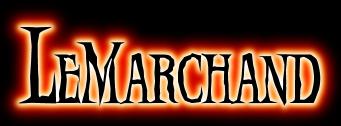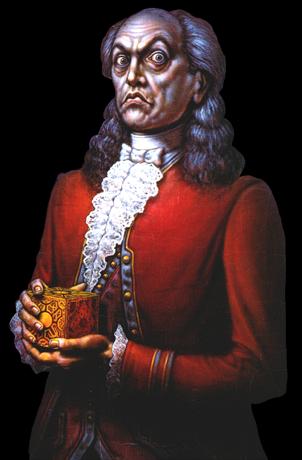

A bit about the notorious Creator of the Lament
Configuration.
Excerpts from Clive Barker's Book of the Damned III,
Epic Comics
|
LeMarchand, Philip (1717 - ?), was a French architect, artisan, and designer who is posthumously credited as possibly one of the most prolific, if undiscovered, mass murderers in the history of the modern world. He first became known for his creation of bizarre, intricately designed music boxes which quickly became the rage of Europe. The boxes, known in some circles as LeMarchand Boxes, were each one of a kind creations which were also puzzles, with the answer to one's ultimate hearts desire as their solution. At the height of his career, Paris was besieged by scandalous multiple disappearances of noteworthy individuals, a number of whom had purchased LeMarchand's puzzle boxes.Suspicions, though unconfirmed, fell upon the sculptor / architect, especially inasmuch as LeMarchand's apprentice, the son of a respected clock maker, was the first to disappear. Amidst this notoriety, LeMarchand fled Europe without selling his home. Apparently certain that the authorities were closing in on him, LeMarchand discarded his already floundering career. The exact charges which would have been brought against him are unknown for most legal records regarding LeMarchand were either expunged after his disappearance, or destroyed in the early part of World War Two. LeMarchand, like Moses the lawgiver found his name struck from most records. The Legend. In certain circles, the name LeMarchand is synonymous with dread and horror. This "architect of the damned" served agents far more sinister than those served by Hitler's own architect, Albert Speer. the atrocities performed by LeMarchand made him one of France's most infamous figures, rivaled only by the DeVincouer family and Gilles de Rais (who had a profound effect on LeMarchand's own courting of what he called the "Lords of Order"). Yet, despite his notoriety, little is actually known about the man himself. Almost all of the information we have is based on rumor and speculation. Nearly all of his architectural creations were destroyed during World War II, and very few records remain documenting the events in his life. We do know that he was educated at the Academie Royale de Pienture et Sculpture in Paris in the early seventeen hundreds, that he was a freemason, that he moved to New York to pursue "more loftier pursuits than the mundane and oppressive tedium of a drafting table," that he later entered a competition to design the President's House, and that he had a devoted interest in the occult. It is this last association of Philip LeMarchand, that has
resulted in his infamy. It was LeMarchand's interest in the supernatural which
directly influenced the creation of his multitude of highly sought after puzzle
boxes, which are rumored to either reveal great secrets and pleasures when
solved, or death and the atrocities of Hell, depending on who you listen
to. Beyond this the only major surviving references are a brief mention in Bolinger's Encyclopedia of the Occult (1946) and a chapter on his architecture in Kaufmann's French Architecture of the Eighteenth Century (1936), which reveals little biographical information about the man himself, but does contain numerous illustrations of LeMarchand's buildings which no longer exist themselves. Late architecture. It is known that LeMarchand did live for several years beyond his disappearance from French and British artistic and social circles. He made a living by selling his puzzles throughout Europe, at a substantial decrease to what he was receiving for them at auction during the height of his fame. He supplemented this income by returning to architectural design. This we know from the completion dates of buildings ascribed to him. These buildings, numbering about thirty, are all believed to have been larger versions of his puzzle boxes. |
 |
|
The majority of these structures, again, are believed to have been destroyed during the World Wars. Others met their ends in suspicious blazes, and in order to make room for newer buildings. We also know that a few of his architectural designs were not carried out until well after his death. The world famous Carrbord Hansen's Disease Center is one of these. The Final Years. There are surprisingly few documents in existence to provide us with this missing information. Reportedly the de Moret family purchased the contents of LeMarchand's New York house, where horrors depicted in this journal were committed. The house itself was razed to the ground as an abode of evil, and the site remained a vacant lot for a number of years. The site, at 70 Washington Square South, now houses New York University's Elmer Holmes Bobst Library, which strangely enough, structurally represents one of LeMarchand's boxes. LeMarchand's Legacy. It is believed this genius constructed more than 270 of his puzzle boxes before he vanished. These boxes change hands rapidly, as is expected, though there are a few collectors, who are interested in the boxes as objects of admiration, and have no interest in working their wonders. One of LeMarchand's boxes has been appeared recently on the album cover of the goth rock group, The Cult of Joseph, showcasing a release entitled Chain of Souls. The agency representing the band recently announced that the band's tour bus had mysteriously disappeared between engagements in Muncie and Gary, Indiana. As to whether or not LeMarchand made his peace with God, that is the biggest enigma remaining. Who knows what the consequences of solving it will bring? We know that in order for LeMarchand to create his boxes, he needed human fat, lots of it, so therefore he had to murder a great deal. This he must have done quietly, taking only people whose absence would go unnoticed, for we have no records of any European manhunt during the time he returned to France. LeMarchand was 94 years old when he checked into L'Hotel D'Armais. He was never seen checking out. When the hotel management finally entered his room they found it empty except for the furnishings, and one of LeMarchand's own boxes which sat on the floor amongst a great deal of blood. LeMarchand's final exit. Or was it? For all we know, this could be the scene of another one of LeMarchand's offerings to the Cenobites. He, himself could have slipped quietly away, dying in obscurity for all we know. During his time there was much speculation. No obituary ever appeared for him, and reported sightings of him, including back in the Colonies, became nearly as frequent as today's Elvis sightings. We may never know what happened to Philip LeMarchand. Any journals that he may have kept following his flight from New York remain missing, and even if they were to turn up, who, other than Brian Tolquist, has ever had the fortune to write an entry relating their own death? Nonetheless, LeMarchand's dark legacy continues to affect our world to this day. |
